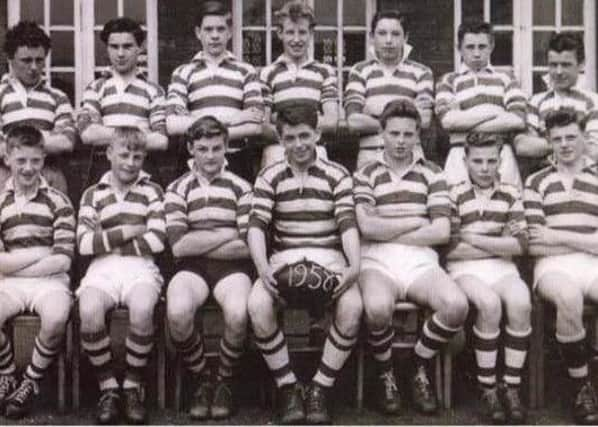Every picture tells a story...


The heading for this piece is a statement we see quite regularly, but in this case it tells more than one story.
The picture is of the rugby league team at Windermere Road Secondary Modern School, Leigh, in 1958, as we can see written on the ball .
Advertisement
Hide AdAdvertisement
Hide AdSome years ago I was informed by the captain of the team who is holding the ball, that the picture was taken before the team played a local cup final, between themselves and the powerful Manchester Road (Leigh) secondary school team, who would have had four times as many boys to choose from and were coached by the schoolboy legendary teacher and rugby league coach, Bert Causey.
Ken Isherwood, the teacher at Windermere Road, would have assembled this enthusiastic group covering two school years, to play the game.
The result according to the captain was Windermere Road 2 Manchester Road, Plenty (the captain’s way of putting it).
We now come to the stories behind the some people in the picture.
From this small school came three legends of our town.
Advertisement
Hide AdAdvertisement
Hide AdFirstly we look at the captain (middle of the front row) Clive Powell.
As we can see he was in those days a big lad but his fortune has not to be found on the rugby league fields
of the North but on the world stage as a jazz musician.
As I am sure most people will know him as Georgie Fame.
For readers who do not know Clive’s story – and there will not be many – here is a quick resume of his life after school.
Clive left school at 15 and like the rest of his family he went into the cotton industry at Lilford Mill as an apprentice spinner.
Advertisement
Hide AdAdvertisement
Hide AdBut this was never going to be his chosen vocation, it was serving as a means to an end.
His weekends were spent playing piano in the local pubs with “The Dominoes” who were a local group.
By the age of 16 he had headed for the bright lights of London.
It wasn’t long before Clive was playing piano in Billy Fury’s backing band and, after a split in the band, Clive had a few false starts but he then landed a three-year contract at the Flamingo club with his band “The Blue Flames”.
Advertisement
Hide AdAdvertisement
Hide AdSuccess came with his first number one “Yeh Yeh” which incidentally knocked the Beatles off top spot, this was followed by another number one, the “Ballad of Bonny and Clyde”.
He has had 14 hit singles and recorded 20 albums during his career.
Clive’s love of jazz saw him recognised as one of the world’s best when in 1967-68 he became singer with the Count Bassie orchestra.
In 1997, he teamed up with Bill Wyman of the Rolling Stones to form “The Rhythm Kings,” who still tour on a regular basis.
Advertisement
Hide AdAdvertisement
Hide AdIt would be difficult to state all of Clive’s musical life in such a short piece but one thing is certain, the picture we have shown holds pride of place in his studio hall of fame, alongside the likes of Mose Allison, Count Bassie Duke Ellington Alan Price and Bill Wyman plus many more stars of the music industry.
Clive told me some time ago that he delights in telling the star visitors to his studio about the picture although he never tells them the score in that particular game.
Seated second right front row is Colin Tyrer, rugby league legend of Leigh (112 games), Wigan(246) Barrow (46) and Hull KR (31).
Colin was a prolific goal kicker with 1,125 career goals to his name, he was no slouch in the try scoring either, accruing 92.
Like Clive, Colin’s career had its ups and downs.
Advertisement
Hide AdAdvertisement
Hide AdThe down point came in the 1970 Challenge Cup Final against Castleford when, after kicking a penalty goal, Keith Hepworth the Castleford scrum-half smashed Colin’s jaw with his elbow.
This was a deliberate ploy, alleged many, to deprive Wigan of their specialist goal kicker, a ploy – if it was one – which worked as Cas won a tight game 7-2 .
The third town hero also went on to play rugby league at the top.
He is second left, front row, and is Frankie Parr.
By 1961, Frankie had joined Wigan, he was a tough uncompromising scrum-half.
Advertisement
Hide AdAdvertisement
Hide AdHe played 309 games, Wigan being his only club, and scored 95 tries and kicked 15 goals.
Frankie played until 1971 and during his time played in three Wembley finals 65,66 and Colin’s ill-fated 70 final.
Two lads from the small Windermere Road school at Wembley was a fantastic achievement by anyones standards.
We will not forget the rest of these lads either – the full team was, back row from left, Benny Bradley, Eric Taylor, Bill Porter, Keith Richardson, Eric Thomson, Syd Buxton. Front from left, Eric Holcroft, Frankie, Billy Wardle, Clive, Barry Bardsley, Colin, Stan Culpin.
Advertisement
Hide AdAdvertisement
Hide AdJust a note on a couple of the other players: Billy Wardle and Barry Bardsley went on to play for Leigh Miners and Barry developed a successful heavy haulage recovery business which still operates today.
One last but valid contribution from Clive, during that unsuccessful game of rugby league was that he kicked the goal and not the legendary goal kicker, Colin Tyrer, that he says is his claim to fame (no pun intended).